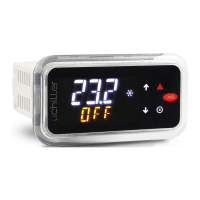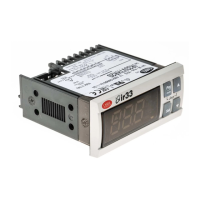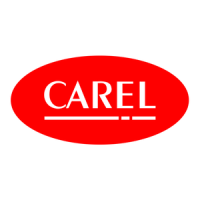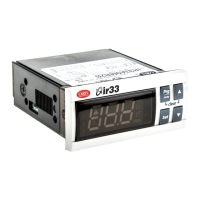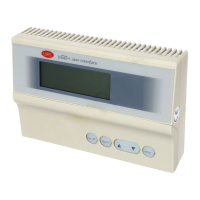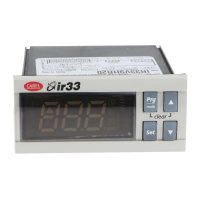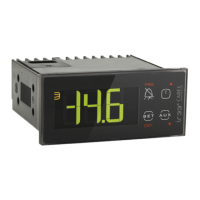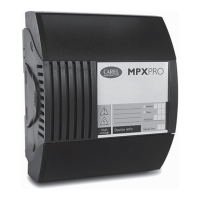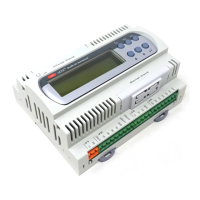35
ENG
UltraCella +0300083EN - rel. 1.5 - 07.02.2015
Below are indicated the parameters used to explain the selections for A5
and A9.
1 = Immediate external alarm
Application: external alarm that requires immediate activation (for
example, high pressure alarm or compressor thermal overload). The
activation of the alarm:
1. • shows the message on the display (IA);
• activates the buzzer, if enabled;
• activates the alarm relay, if selected;
2. involves the following actions on the actuators:
• compressor: operates depending on the values assigned to
parameter A6 (stop compressor on external alarm).
• fans: continue to operate according to the fan parameters (F).
Note:
• when stopping the compressor, the minimum ON time (c3) is ignored.
• if more than 1 input is confi gured on immediate alarm, the alarm is
generated when one of the inputs is opened.
2 = Do not select
3 = Enable defrost
Application: Any defrost request arriving when the contact is open will
remain pending until the contact closes.
A5/ A9 = 3
Contacts Defrost
Open Not enabled
Closed Enabled (defrost start is still determined by the control)
Close with active
defrost
when the digital input is opened, the defrost is
immediately stopped and the unit restarts normal
operation (without performing the dripping or post-
dripping phases). The LED starts fl ashing to indicate
that the defrost request is pending, waiting for the next
enabling signal (closing of the contact), when the defrost
will be performed completely.
Tab. 4.d
Note: this function is useful to prevent defrosts on the units
accessible by the public during opening times.
4 = Start defrost from external contact
Application: this feature is useful in case you need to perform synchronized
defrost across multiple units or otherwise manually controlled by an
external contact. To perform the defrosts, connect a cyclical, mechanical
or electronic timer to the digital input. You can connect multiple units
at the same timer and set diff erent values for the parameter d5 (defrost
delay from multifunction input) to avoid simultaneous defrosts.
Timer
Defrost
UNIT 1
UNIT 2
UNIT 3
Defrost
Defrost
t
dP(1)
d5(2)
d5(3)
dP(2) dP(3)
OFF
ON
OFF
ON
OFF
ON
OFF
ON
Fig. 4.m
Key
dP Maximum defrost duration
UNIT 1…3 Unit 1…3
d5 Defrost delay form digital input
t Time
5 = Do not select
6=On/Off remote
The digital input can also be programmed as a remote ON/OFF switch.
When the control is set to OFF:
• the temperature is displayed alternately with the message “OFF”, the
internal timer relative to the parameter dI is updated. If dI expires when
the unit is OFF, a defrost is performed when the unit is switched on
again;
• the auxiliary relays remain active set as an auxiliary output and light,
the other auxiliary outputs are off ;
• the buzzer and the alarm relay are off ;
• the control does not perform the control functions, defrosts, continuous
cycle, temperature alarm signalling and all the other functions;
• the compressor protection times are respected.
At control restart, all functions are reactivated, except:
• defrost at start-up;
• compressor and fan delay at start-up.
Note: The ON/OFF from external digital input has priority over the
keypad and the supervisor.
7 = Do not select
8 = Low pressure switch
By setting A5/A9=8 you can manage the low pressure switch. The low
pressure alarm “LP” is signalled when the low pressure switch is triggered:
• during normal regulation, with active compressor and pump down
function is disabled (c7=0)
• with pump-down function enabled (c7 >0), if the pump down valve is
opened and the compressor is active.
The low pressure alarm signal is delayed by the time set for parameter A7.
The low pressure alarm ‘LP’ stops the compressor.
1 21 2
1 21 2
9, 10, 11 = Do not select
12 = Auxiliary output
Setting H1/H5 = 2 the corresponding output AUX1/ AUX2 is activated by
the key AUX1/ AUX2. Besides, it is possible to use alternatively one digital
input DI2 or DI3 (set A5 or A9=12) to drive output AUX2 or AUX3. In this
case the key and the digital input have the same priority as regards the
switch on.
13 = Do not select
14 = Continuous cycle activation
Activation: passage of the contact from opened to closed;
Deactivation: passage of the contact from closed to opened.
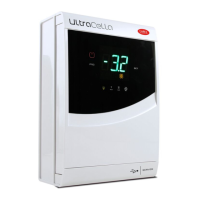
